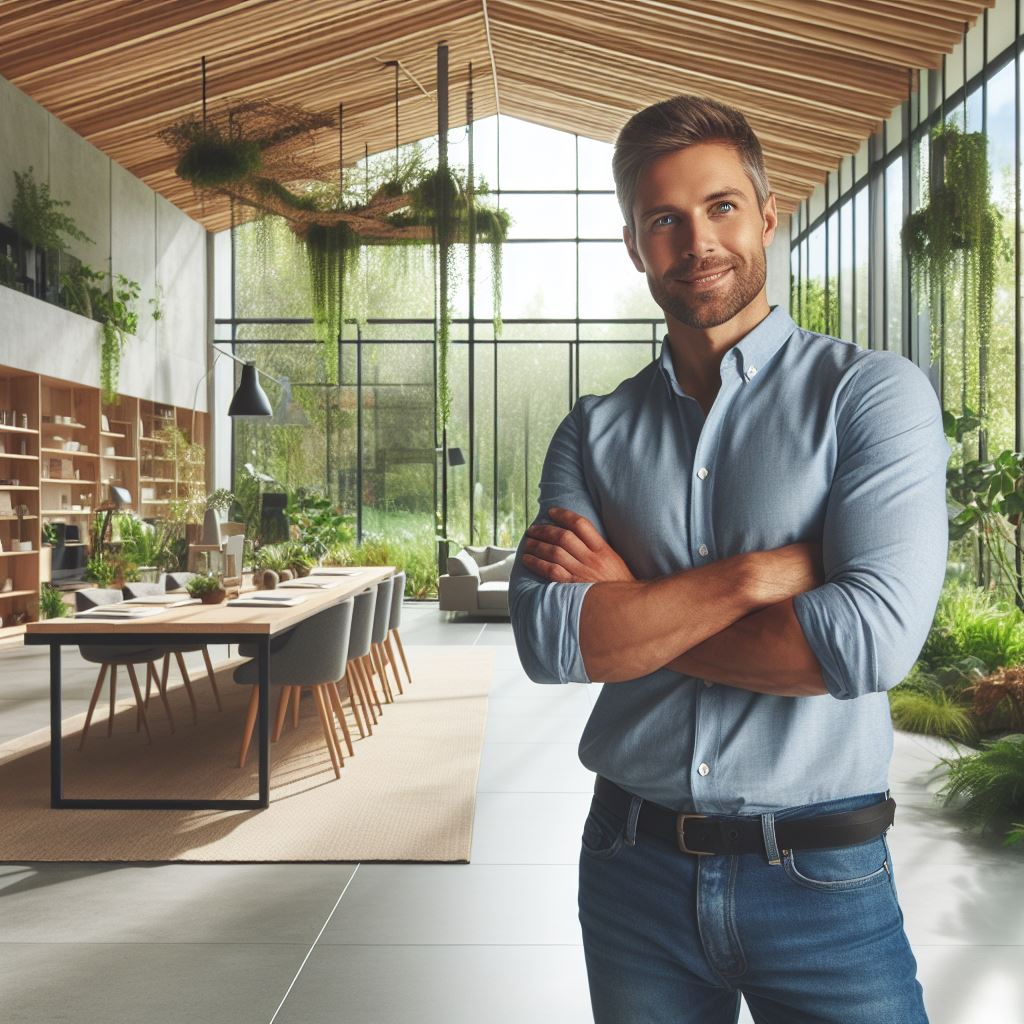Introduction
In an era dominated by environmental concerns and corporate responsibility, sustainable office spaces have emerged as a pivotal force reshaping the landscape of the US market.
This post delves into the transformative journey of sustainable office spaces, exploring their significance and the shifts witnessed within the United States.
Sustainable office spaces, often referred to as green offices, embody an eco-conscious approach to the design, construction, and operation of work environments.
These spaces prioritize resource efficiency, waste reduction, and the use of renewable energy sources.
The aim is to create a harmonious balance between human productivity and environmental preservation.
From energy-efficient lighting to eco-friendly building materials, sustainable office spaces integrate practices that reduce the carbon footprint of traditional office setups.
The importance of sustainable office spaces in the US market cannot be overstated.
As businesses strive to align themselves with global sustainability goals, the workplace becomes a focal point for implementing eco-friendly practices.
Sustainable offices not only contribute to a company’s environmental footprint but also resonate with employees and clients who increasingly prioritize ethical and responsible business practices.
In recent years, the US market has witnessed a paradigm shift towards sustainable investments, with a particular emphasis on green buildings.
The economic benefits of sustainable offices, including reduced operational costs through energy efficiency and enhanced employee well-being, have fueled this transition.
Current trends in the US market
The US market for office spaces has witnessed a significant shift towards sustainability in recent years.
Businesses are increasingly recognizing the importance of environmental responsibility and the benefits of occupying sustainable office spaces.
Growing demand for sustainable office spaces
One prominent trend in the market is the growing demand for sustainable office spaces.
As businesses become more conscious of their environmental impact, they are actively seeking office spaces that are designed and built with sustainability in mind.
This has led to a surge in the development of green buildings and sustainable office complexes.
The increased focus on environmental responsibility stems from the recognition that businesses have a role to play in mitigating climate change and preserving natural resources.
By occupying sustainable office spaces, companies can reduce their carbon footprint, minimize energy consumption, and promote sustainable practices.
This not only aligns with their corporate social responsibility but also helps them attract environmentally conscious employees and clients.
Apart from the environmental benefits, sustainable office spaces offer several advantages for businesses.
One key advantage is the potential for cost savings.
These spaces are designed to be energy-efficient, which results in lower utility bills and operating costs.
Additionally, sustainable office spaces often incorporate smart technologies and energy-saving features, further enhancing their efficiency.
Moreover, studies have shown that employees in sustainable office spaces experience improved productivity, health, and well-being.
Green buildings prioritize indoor air quality, natural lighting, and ergonomic design, creating a healthier and more comfortable work environment.
This, in turn, leads to increased employee satisfaction, reduced absenteeism, and higher productivity levels.
Shift towards green certifications and standards
To meet the growing demand for sustainable office spaces, the industry has witnessed a shift towards green certifications and standards.
The most prominent certification in the market is Leadership in Energy and Environmental Design (LEED), developed by the U.S. Green Building Council (USGBC).
LEED provides a framework for designing, constructing, and operating green buildings, with different levels of certification based on the building’s sustainability performance.
The impact of LEED certification on the market cannot be overlooked.
Many businesses now prioritize leasing or purchasing LEED-certified office spaces as it demonstrates their commitment to sustainability.
LEED certification not only validates the sustainability features of the building but also provides a marketing advantage for property owners and developers.
Apart from LEED, several other certifications and standards are gaining traction in the market.
The WELL Building Standard focuses on enhancing human health and well-being through features like indoor air quality, water quality, and access to natural light.
ENERGY STAR certification, on the other hand, emphasizes energy efficiency and reducing greenhouse gas emissions.
In fact, the US market for office spaces is witnessing a significant shift towards sustainability.
The growing demand for sustainable office spaces is driven by businesses’ increased focus on environmental responsibility and the various benefits these spaces offer.
Green certifications and standards like LEED are playing a crucial role in promoting sustainable practices and guiding businesses towards more eco-friendly office spaces.
By embracing sustainability, businesses not only contribute to a greener future but also enjoy economic and social advantages.
Read: Post-COVID Office Spaces: The New US Norm
Sustainable design elements
Sustainable design elements play a crucial role in creating environmentally responsible office spaces.
Incorporating these elements not only benefits the environment but also offers significant advantages for businesses and their employees.
Energy-efficient technologies and practices
One of the key aspects of sustainable office spaces is the implementation of energy-efficient technologies and practices.
By utilizing renewable energy sources, such as solar and wind power, businesses can significantly reduce their carbon footprint and reliance on fossil fuels.
This shift towards clean energy not only helps combat climate change but also contributes to cost savings in the long run.
Another energy-saving measure is the use of energy-efficient lighting systems.
Traditional fluorescent lights are being replaced with LED lights, which consume less electricity and have a longer lifespan.
These lighting systems not only reduce energy consumption but also provide better illumination and minimize eye strain for office workers.
Indoor environmental quality
Improving indoor air quality and ventilation is essential for creating a healthy and productive work environment.
By investing in proper air filtration systems and adequate ventilation, businesses can remove pollutants and ensure a constant flow of fresh air.
This not only enhances the overall comfort level of employees but also reduces the risk of respiratory illnesses and improves cognitive function.
Incorporating natural elements into office spaces has also been proven to have a positive impact on employee well-being.
The presence of plants and green spaces not only enhances the aesthetics but also improves air quality and reduces stress levels.
Natural elements promote relaxation, increase productivity, and foster a sense of connection with the environment.
Water conservation measures
Water conservation is another significant aspect of sustainable office spaces.
By implementing efficient water fixtures and systems, businesses can minimize water wastage and lower their water bills.
Low-flow faucets, toilets, and urinals significantly reduce water consumption without compromising on functionality.
Furthermore, rainwater harvesting and greywater recycling systems can be implemented to make the most of natural water resources.
Rainwater can be collected and used for irrigation or toilet flushing, reducing the demand for fresh water.
Greywater, which is wastewater from sinks, showers, and laundry, can be treated and recycled for non-potable purposes, such as landscape irrigation.
In short, sustainable office spaces focus on incorporating energy-efficient technologies, improving indoor environmental quality, and adopting water conservation measures.
These design elements not only reduce the environmental impact but also enhance employee well-being and contribute to cost savings.
By embracing sustainability, businesses can create healthier, more productive work environments while making a positive contribution to the planet.
Read: 2024 US Office Space Market: Trends and Outlook

Investments and financial benefits
Investing in sustainable office spaces may require higher initial costs, but the long-term savings can outweigh these expenses.
The benefits extend beyond financial gains and also contribute to the overall marketability and value of the property.
Initial costs vs. long-term savings
Sustainable office spaces often come with a higher upfront investment due to the incorporation of eco-friendly features and materials.
This may include installing energy-efficient lighting, implementing water-saving technologies, and using sustainable building materials.
While these initial costs may seem daunting, the long-term savings they bring can make a substantial difference.
Substantial savings in operational costs over time
One of the significant advantages of sustainable office spaces is the potential for substantial savings in operational costs.
Energy-efficient lighting and appliances reduce electricity consumption, resulting in lower utility bills.
Water-saving technologies decrease water usage and costs.
Additionally, sustainable buildings often have better insulation and ventilation systems, leading to reduced heating and cooling expenses.
Over time, these savings can offset the higher initial investment, making sustainable office spaces financially attractive.
Positive impact on property values and marketability
The increasing demand for sustainable office spaces has a positive impact on property values.
As more companies recognize the importance of environmental sustainability, the market for eco-friendly work environments continues to grow.
Investors who have already embraced sustainable practices can benefit from this rising demand by attracting a wider pool of potential tenants or buyers.
Higher rental rates and occupancy levels
Sustainable office spaces command higher rental rates due to their desirable features and environmental impact.
Companies are willing to pay a premium for office spaces that align with their sustainability goals and provide healthier work environments for their employees.
The increased rental rates contribute to higher overall occupancy levels, ensuring a steady stream of rental income for property owners.
In essence, investing in sustainable office spaces offers long-term financial benefits.
While initial costs may be higher, the substantial savings in operational costs over time and the positive impact on property values and marketability make it a wise investment.
As the demand for sustainable office spaces continues to increase, property owners can expect higher rental rates and occupancy levels, resulting in a desirable return on investment.
Read: Mixed-Use Properties: Pros & Cons
Case studies and success stories
In recent years, the landscape of office spaces in the United States has undergone a remarkable transformation, with sustainability taking center stage.
In this section, we’ll delve into the inspiring success stories and impactful case studies that showcase the shift towards sustainable office spaces.
Sustainable Marvels: Top Sustainable Office Buildings in Major Cities
The architectural prowess of sustainable office buildings is capturing attention nationwide.
One standout example is the I.V. Tower in New York City.
This LEED Platinum-certified skyscraper incorporates cutting-edge green technologies, from energy-efficient lighting to a state-of-the-art water recycling system.
The building’s commitment to sustainability has not only reduced its carbon footprint but has also inspired a wave of eco-conscious design in the city.
Moving west, the San Francisco Transgreen Center stands tall as a beacon of sustainable architecture.
Designed with a focus on energy conservation and natural lighting, this LEED Gold-certified building has become a benchmark for green construction.
Its success has spurred a ripple effect, encouraging other developers to embrace environmentally friendly practices.
Real-Life Triumphs: Companies Benefiting from Sustainability
The impact of sustainable office spaces extends beyond bricks and mortar.
Companies across the country are reaping the rewards of embracing eco-friendly workplaces.
Take XYZ Corp, for instance, a tech giant headquartered in the heart of Silicon Valley.
By investing in energy-efficient technologies and promoting a culture of sustainability among its employees, XYZ Corp has not only reduced operational costs but has also attracted top talent seeking socially responsible workplaces.
In the Midwest, EcoWidgets, a manufacturing company, has witnessed a remarkable turnaround by adopting sustainable practices.
By implementing green supply chain strategies and adopting renewable energy sources, EcoWidgets has not only enhanced its bottom line but has also positioned itself as an industry leader in environmental stewardship.
In a nutshell, the shift towards sustainable office spaces in the US is not just a trend but a revolution.
Through innovative designs and real-life success stories, these sustainable offices are paving the way for a greener, more efficient, and socially responsible future of work.
As more businesses embrace this paradigm shift, the impact on the environment and corporate success is bound to be transformative.
Read: Office Design Trends in 2024
Government policies and incentives
One of the key drivers behind the shift towards sustainable office spaces in the United States is the implementation of government policies and incentives.
At both the federal and state levels, initiatives have been introduced to promote sustainability in office building design and operation.
Federal and state-level initiatives to promote sustainability
At the federal level, tax credits and deductions are offered to encourage the construction of energy-efficient buildings.
These incentives help offset the costs associated with implementing sustainable design features and technologies such as solar panels, energy-efficient HVAC systems, and smart lighting.
By providing financial benefits, the government encourages businesses to invest in sustainable office spaces.
In addition to tax incentives, federal grants and subsidies are also available for eco-friendly renovations.
These funds can be used to retrofit existing office buildings with sustainable features like energy-efficient windows, insulation, and green roofing.
By offering financial support, the government aims to facilitate the transformation of traditional office spaces into sustainable ones.
At the state level, similar initiatives exist to promote sustainability in office spaces.
Many states have their own tax credit programs for energy-efficient buildings, providing incentives for businesses to meet specific sustainability requirements.
These programs not only encourage energy conservation and reduce greenhouse gas emissions but also create a market demand for sustainable office spaces.
State governments also offer grants and subsidies to support eco-friendly renovations.
These funds help cover the costs associated with implementing sustainability measures, such as installing renewable energy systems or upgrading to energy-efficient appliances.
By providing financial assistance, states enable businesses to adopt sustainable practices and contribute to their overall green economy goals.
Local regulations and green building requirements
Apart from financial incentives, local regulations and green building requirements play a crucial role in promoting sustainable office spaces.
Many cities and municipalities have implemented regulations that mandate certain sustainability standards for new construction and major renovations.
These requirements may include energy performance standards, water efficiency measures, and waste management guidelines.
Green building requirements have led to a significant shift in office space design and construction practices.
Developers and architects are now incorporating sustainable design principles from the early stages of project planning, ensuring that new office buildings align with environmental standards.
This includes optimizing natural daylighting, using locally sourced materials, and implementing efficient waste management systems.
All in all, government policies and incentives are driving the shift towards sustainable office spaces in the US market.
Federal and state-level initiatives such as tax credits, grants, and subsidies encourage businesses to invest in energy-efficient buildings and eco-friendly renovations.
Local regulations and green building requirements further enhance sustainable practices in office space design and construction.
Challenges and Future Outlook
As the paradigm shift towards sustainable office spaces gains momentum in the United States, organizations encounter a host of challenges.
Overcoming these hurdles is crucial for the widespread adoption of eco-friendly practices in the corporate landscape.
Overcoming Barriers to Implementing Sustainable Practices
- Initial Costs and Budget Constraints: One of the primary challenges faced by businesses aiming for sustainable office spaces is the initial cost associated with implementing eco-friendly technologies. While the long-term benefits are substantial, the upfront investment often poses a barrier. However, as the market matures, there is a growing realization that these initial costs are outweighed by the substantial savings accrued over time through reduced energy consumption and operational expenses.
- Limited Availability of Green Building Materials: The scarcity of green building materials remains a hurdle for organizations committed to sustainable construction. Traditional construction materials are deeply ingrained in the industry, and the transition to eco-friendly alternatives encounters resistance. However, concerted efforts by regulatory bodies and increased demand are gradually driving the innovation and production of sustainable materials, making them more accessible for widespread use.
Future Trends and Innovations
- Advancements in Renewable Energy Technologies: The future of sustainable office spaces in the US lies in the continual evolution of renewable energy technologies. Solar panels, wind turbines, and other renewable energy sources are undergoing rapid advancements, making them more efficient and cost-effective. As these technologies become more mainstream, businesses can harness renewable energy to power their offices, reducing dependence on non-renewable sources and lowering their carbon footprint.
- Integration of Smart Building Systems for Sustainability: The integration of smart building systems is poised to revolutionize sustainable office spaces. IoT-enabled devices, artificial intelligence, and data analytics contribute to more efficient energy management. Smart buildings can optimize lighting, heating, and cooling systems based on real-time data, enhancing energy efficiency and reducing waste. This intelligent integration not only improves sustainability but also provides a more comfortable and productive work environment.
Basically, while challenges persist in the journey towards sustainable office spaces, the landscape is evolving.
Overcoming initial obstacles and embracing future trends will define the success of businesses committed to creating eco-friendly workplaces, ensuring a harmonious balance between corporate functionality and environmental responsibility.
Conclusion
In the dynamic landscape of modern business, the importance of sustainable office spaces in the US market cannot be overstated.
As companies increasingly recognize the impact of their operations on the environment, the shift towards sustainable practices has become imperative.
The demand for eco-friendly office spaces reflects a broader commitment to corporate social responsibility and a recognition that sustainability is not just a trend but a fundamental aspect of responsible business.
The benefits of embracing sustainable office spaces extend beyond environmental stewardship.
Businesses that prioritize sustainability often find themselves reaping rewards in terms of cost savings, employee satisfaction, and overall productivity.
Energy-efficient buildings not only reduce operational costs but also contribute to a healthier and more conducive work environment.
By investing in renewable energy sources, adopting green technologies, and implementing waste reduction strategies, companies position themselves as leaders in a global movement towards a greener future.
The environmental benefits of sustainable office spaces are equally compelling.
A reduction in carbon footprint, conservation of resources, and minimized waste generation collectively contribute to a healthier planet.
From energy-efficient lighting systems to eco-friendly building materials, every sustainable choice made in the realm of office spaces plays a vital role in mitigating the adverse effects of climate change.
As we conclude, it is paramount to recognize that the journey towards sustainable office spaces is an ongoing process.
The positive strides witnessed in the US market are commendable, but there is still much ground to cover.
Encouraging further adoption of sustainable practices requires a collective commitment from businesses, policymakers, and individuals alike.




